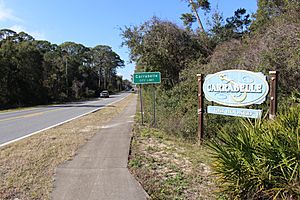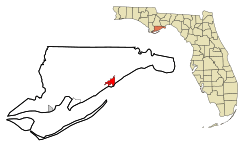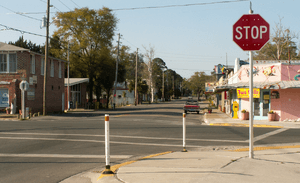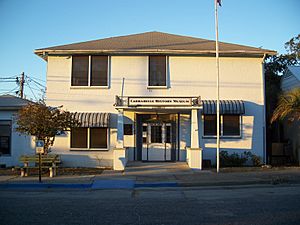Carrabelle, Florida facts for kids
Quick facts for kids
Carrabelle, Florida
|
|
|---|---|
| City of Carrabelle | |

City entrance sign
|
|
| Motto(s):
"Get hooked"
|
|

Location in Franklin County and the state of Florida
|
|
| Country | |
| State | |
| County | Franklin |
| Settled (Rio Carrabella) | 1877 |
| Incorporated | May 11, 1893 |
| Government | |
| • Type | Commission–Manager |
| Area | |
| • Total | 5.93 sq mi (15.35 km2) |
| • Land | 4.79 sq mi (12.40 km2) |
| • Water | 1.14 sq mi (2.95 km2) |
| Elevation | 26 ft (8 m) |
| Population
(2020)
|
|
| • Total | 2,606 |
| • Density | 544.39/sq mi (210.18/km2) |
| Time zone | UTC-5 (Eastern (EST)) |
| • Summer (DST) | UTC-4 (EDT) |
| ZIP Code |
32322
|
| Area code(s) | 850 |
| FIPS code | 12-10725 |
| GNIS feature ID | 0280069 |
Carrabelle is a city in Franklin County, Florida. It's located on Florida's Panhandle, where the Carrabelle River meets the Gulf of Mexico. In 2020, about 2,606 people lived here. Carrabelle is known for its beautiful coastal setting and interesting history.
Contents
History of Carrabelle
Early Days and Spanish Explorers
In 1528, a Spanish group led by Pánfilo de Narváez traveled through this area. Later, in the late 1600s and early 1700s, Carrabelle, Dog Island, and St. George Island were used as starting points for attacks on nearby ports.
Founding the Town
In 1876, an explorer named Nathaniel Holmes Bishop explored the rivers nearby. The next year, in 1877, Oliver Hudson Kelley from Massachusetts founded the town. He named it "Rio Carrabella" after his niece, Caroline Hall. She became the town's first postmaster. Carrabelle officially became a town on December 24, 1881.
Growth and Challenges
In 1891, the Carrabelle, Tallahassee and Georgia Railroad was built. This connected Carrabelle to Tallahassee and eventually to Augusta, Georgia. The city was officially made a city by the Florida government in May 1893.
On August 1, 1899, a hurricane hit Carrabelle. It almost destroyed the entire town, leaving only nine homes standing.
World War II and Recent Events
During World War II, a place called Camp Gordon Johnston opened in 1942. It was used to train soldiers for water landings on nearby beaches. About 250,000 men trained there before the camp closed in 1946.
More recently, on August 23, 2008, Tropical Storm Fay made its fourth landfall in Florida right in Carrabelle.
Geography and Climate
Carrabelle is in the eastern part of Franklin County. It sits along the Carrabelle River and on St. James Island. To the south is Dog Island, which separates St. George Sound from the Gulf of Mexico.
U.S. Route 98 goes through Carrabelle. It leads west about 22 miles (35 km) to Apalachicola. It goes northeast about 30 miles (48 km) to Medart. Tallahassee, Florida's capital city, is about 54 miles (87 km) northeast.
Carrabelle covers about 5.93 square miles (15.35 km²). Most of this area is land, but about 1.14 square miles (2.95 km²) is water. Carrabelle is also the eastern end of the Gulf Intracoastal Waterway, which is a path for boats along the coast.
The weather in Carrabelle is usually hot and humid in the summer. Winters are generally mild to cool. This type of weather is called a "humid subtropical climate."
Population and People
Carrabelle's population grew from 1,303 people in 2000 to 2,778 in 2010. This happened because the city limits expanded to include the Franklin Correctional Institution.
In 2020, there were 2,606 people living in Carrabelle. About 60% of the people were White, and about 27% were Black or African American. Around 9% of the people were Hispanic or Latino.
Famous People from Carrabelle
- Richard W. Ervin (1905–2004): He was born in Carrabelle. He served as Florida's Attorney General and later as the chief justice of the Florida Supreme Court.
- Caroline A. Hall: The town was named after her, and she was Carrabelle's first postmistress. She was also one of the eight people who started "The Grange," a group for farmers.
- John Jordan "Buck" O'Neil (1911–2006): Born in Carrabelle, he was a famous Negro league baseball player and coach. He later became a scout for the Chicago Cubs. He helped share the history of African-American baseball players before they joined Major League Baseball.
- John Robinson: A well-known aviator.
- Jack Rudloe: A writer and naturalist who moved to Carrabelle when he was 14. His time there greatly influenced him. He helped start the Gulf Specimen Marine Laboratory nearby.
Fun Things to See and Do
Carrabelle has many interesting places and events:
- Boat Parade of Lights
- Camp Gordon Johnston Museum
- Carrabelle Beach
- Carrabelle History Museum
- Carrabelle–Thompson Airport
- Carrabelle Riverfront Festival
- Crooked River Lighthouse
- Historic deepwater fishing village
- McKissack Ponds: Five small ponds near the airport.
- St. James Bay Golf Club
- Tate's Hell State Forest
- Waterway to Dog Island, St George Sound, and the eastern start point of the Gulf Intracoastal Waterway.
- World's Smallest Police Station
The World's Smallest Police Station
Carrabelle is home to the "World's Smallest Police Station." It started on March 10, 1963. The city had a problem with tourists using the police phone for long-distance calls. A phone company worker, Johnnie Mirabella, decided to put the police phone in an old phone booth. This also helped officers stay dry when answering calls in the rain!
The phone booth became very famous. It has been shown on TV shows like Ripley's Believe It or Not! and The Tonight Show Starring Johnny Carson. You can even find T-shirts and postcards of it!
Over the years, the little police station has faced some challenges. Vandals damaged it, and a truck once knocked it over. Hurricane Kate also caused damage. Today, a copy of the phone booth stands in downtown Carrabelle. The original one is kept safe and can be seen at the Carrabelle History Museum.
Museums in Carrabelle
Carrabelle History Museum
The Carrabelle History Museum is located at 106 SE Avenue B, in the old Marvin Justiss building. It's free to visit and tells the story of Carrabelle and the area around it.
Camp Gordon Johnston World War II Museum
The Camp Gordon Johnston World War II Museum is at 1873 Highway 98 West, across from Carrabelle Public Beach. Admission is free. The museum is named after Colonel Gordon Johnston, a soldier who served in several wars.
Crooked River Lighthouse
The Crooked River Lighthouse, built in 1895, is about 2 miles (3.2 km) west of town. It's the tallest lighthouse on the "Forgotten Coast," standing 103 feet (31 m) tall. You can visit the Keeper's House Museum and a gift shop there.
Education
Students in Carrabelle attend schools that are part of the Franklin County Schools system. They go to the Franklin County K–12 School in Eastpoint, Florida, which was built in 2008.
Gallery
See also
 In Spanish: Carrabelle para niños
In Spanish: Carrabelle para niños











